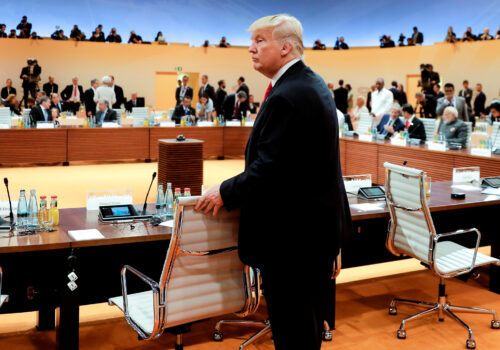After a lackluster G20 in South Africa, Trump can take the group ‘back to basics’ in 2026
One memorable impression left by the 2025 Group of Twenty (G20) Summit under South Africa’s presidency was the empty chairs: six leaders—from the United States, China, Russia, Nigeria, Mexico, and Argentina—were absent. Among these, the United States’ nonappearance was perhaps the most notable, since it is scheduled to host the group in 2026. While other countries sent lower-level representatives to the summit, Washington boycotted this year’s G20 since the beginning, skipping the ministerial preparatory meetings leading up to the November 22-23 summit.
This wasn’t just about the Trump administration’s fraught relations with the South African government. Washington strongly objected to the G20 themes selected by the host—Solidarity, Equality, Sustainability. It also objected to the wide-ranging agenda, which included climate change and global wealth inequality, and US Treasury Secretary Scott Bessent complained that “the G20 has become the G100” due to the large number of invited countries (twenty-two nonmembers were invited). The United States also warned against the G20 issuing a statement at the end of the summit, arguing that given its objections, there is no consensus in the group. US President Donald Trump has even said that South Africa should not be in the G20 anymore.
Meeting participants agreed to issue a declaration at the beginning of the summit instead of the traditional concluding statement, although Argentina said that it did not endorse it. While South African President Cyril Ramaphosa and others have pointed to the declaration as proof of a successful G20 Summit, the declaration more likely reveals the fundamental differences among the group’s members.
So, where does this group go from here?
It’s easier to understand the challenges the 2025 G20 presidency encountered by comparing today’s international circumstances with those surrounding the summits in 2008 and 2009. In the depths of the global financial crisis in 2008, then US President George W Bush elevated the G20—which had started in 1998 as annual meetings of finance ministers and central bank governors in response to the Asian financial crisis—to the level of heads of state or government. Bush did this to move quickly to help coordinate policy measures to quell the crisis. Both the 2008 summit and the G20 Summit in London the following year succeeded in implementing significant and timely stimulus policies, together with pledges not to raise tariffs, to contain the crisis and set the stage for a recovery. Those two G20 summits also launched financial regulatory reforms and the Financial Stability Board to safeguard against future major financial crises. Looking back, it is clear that the factors facilitating the positive outcomes of those G20 summits also included a degree of mutual trust and the perception of common interests and purposes—now largely gone due to geopolitical contention.
Rebuilding this sense of trust and common purpose will take more than one presidency but—to the relief of many members who fear a total US withdrawal from the G20—it appears that the United States will remain engaged with the group, not least because it will play host in the year ahead. Moreover, early indications are that it will take a “back to basics” approach to its presidency that could prove to be productive. The agenda of successive G20 summits have kept expanding to cover many topical issues, including climate finance, inclusive and sustainable growth, sovereign debt problems and global taxation. These have diluted the G20’s focus, making it difficult to come up with concrete solutions.
Trade tensions represent another longstanding factor behind the G20’s current dysfunction. During his first term, Trump raised tariffs against China to rectify its unfair trade practices. The fact that the second Trump administration has doubled down on tariffs—imposing these and other trade restrictions on most countries to different degrees—poses a challenge for future G20 meetings.
However, as the United States prepares to take over the G20 presidency in 2026, there is a chance that the “back to basics” agenda helps facilitate meaningful exchanges of views. As Bessent recently explained, the agenda currently promises to zero in on “unleashing economic prosperity by limiting, eliminating the burdens of regulations, unlocking affordable energy and pioneering new technologies.” In other words, an agenda of economic and financial stability could refocus the G20 and make it more relevant. At the same time, the G20 must overcome the current lack of mutual trust and shared interests to regain its role as the premier forum for global cooperation and coordination.
With the right balance of “back to basics” and a willingness to negotiate key issues such as the range of policy measures to promote growth, energy security, and technological innovation, the Trump administration could make the next G20 Leaders’ Summit, scheduled to take place in December 2026 in Doral, Florida, more relevant than the one that just concluded.
Hung Tran is a nonresident senior fellow at the Atlantic Council’s GeoEconomics Center and senior fellow at the Policy Center for the New South. He is a former managing director at the Institute of International Finance and former deputy director at the International Monetary Fund.
Further reading
Wed, Mar 5, 2025
Has the G20 become the G19?
Econographics By Hung Tran
The US has chosen to boycott the kick-off of South Africa's G20 presidency. But a G20 without the United States or its constructive engagement will be much weaker.
Thu, Oct 16, 2025
African voices are shaping G20 discussions around international financial architecture reform
AfricaSource By
Africa is not merely affected by these reforms. It is actively shaping them.
Tue, Apr 8, 2025
No one is coming to save the global economy
New Atlanticist By Josh Lipsky
Neither the Group of Twenty nor the Federal Reserve should be expected to use their playbook from previous economic crises to respond to economic shocks caused by US tariffs.
Image: A person walks past flags in the media room, on the second day of the G20 Leaders' Summit in Johannesburg, South Africa, November 23, 2025. REUTERS/Yves Herman



